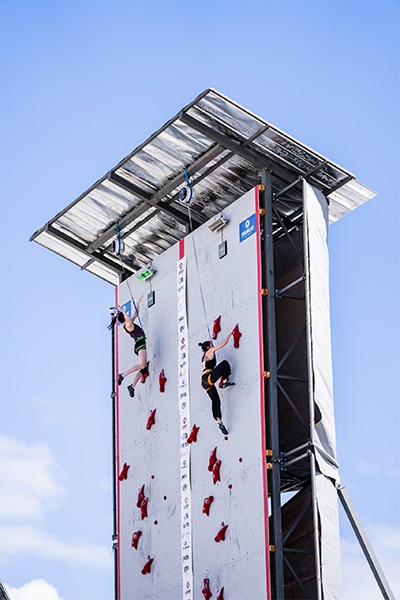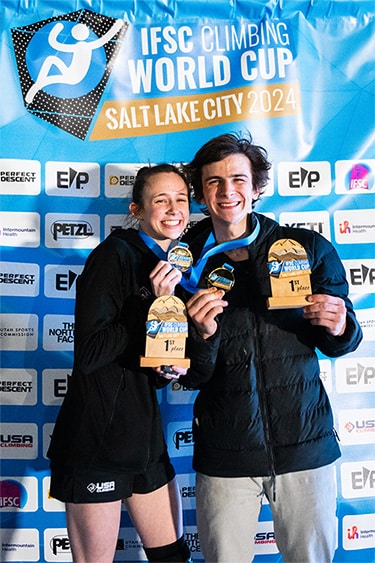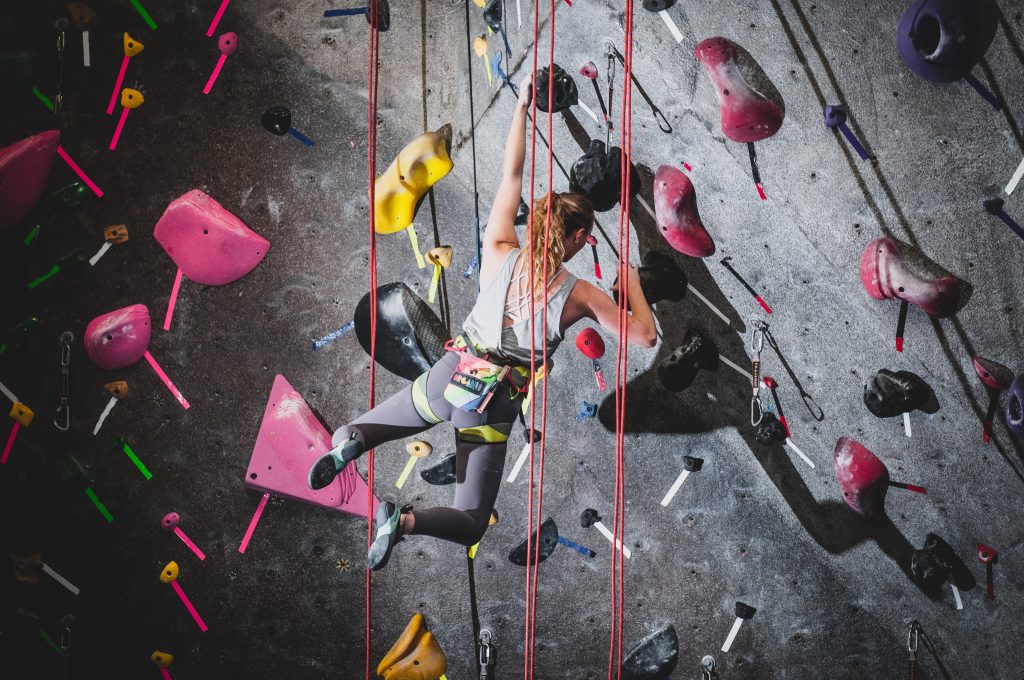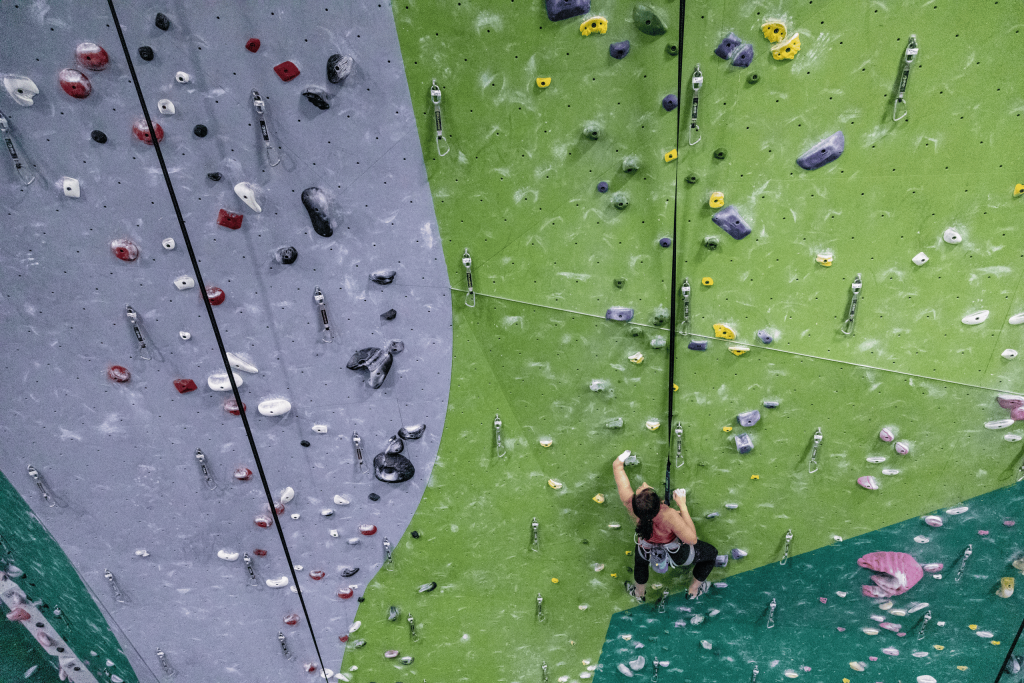Training tips from three of the world’s best speed climbers on how to get started, get better, and get insanely good at speed climbing.
Training Advice from the World's Best Speed Climbers
It’s no coincidence that the two most dominant athletes in the history of US men’s speed climbing are both from the same youth program. Samuel Watson, the current speed climbing world record holder, and John Brosler, the former US national record holder and 10x National Champion, may be nine years apart in age, but both athletes grew up competing for Team Texas before eventually moving up to compete internationally in the IFSC Climbing World Cup circuit.
Unlike most other youth climbing programs across the country, Team Texas was already incorporating all three climbing disciplines (speed, bouldering, and lead) into their daily practice routines as early as 2010, over a decade before speed climbing made its Olympic debut at the 2020 Tokyo Games.
"I got into speed climbing through Team Texas. It was emphasized in practice and training. I remember once Nationals had the speed route for the first time, we immediately built it in one of our gyms, just so we could train. It was part of team practice every day." -- John Brosler
While climbers growing up competing for Team Texas might be a step ahead of the game, as Sam Watson points out, that’s no reason not to give speed climbing a try.
"You only need to compare yourself to yourself. It doesn’t matter what anyone else is doing. It’s the same route and if you can get your time faster, that’s your only goal.” -- Samuel Watson
With that in mind, let’s take a closer look at how someone who is just starting out can go about getting started, getting better, and taking things to the next level in the rapidly growing sport of speed climbing.

How to Start Speed Climbing
Just in case you were starting to get worried, US women’s national record holder Emma Hunt was not a part of Team Texas. Hunt grew up just north of Atlanta, Georgia, where she started climbing at her local climbing gym. When she was just starting out, Hunt was a self-described boulderer with a knack for finishing problems as quickly as possible so that she could pack more routes into every session.
"I was doing as many climbs as I could in a short period of time. All the gym comps would have a point category and be like, ‘How many points can you get?’ I was just a kid, running around, doing every single climb that I could. I always liked moving at a faster pace." --Emma Hunt
Unlike the athletes on Team Texas, Hunt's transition from bouldering to speed climbing was less about being introduced to the sport during practice and more about watching the other, older climbers at her gym racing up the speed wall and wanting to try it for herself.
"Before I joined the Stone Summit Team – and this was back when there weren’t speed auto belays yet and belaying was a bit dangerous--you could only do [speed climbing] if you were on the Stone Summit Team. So I didn't have any access to it, and it was like the forbidden wall. I was like, ‘I just want to climb this. That looks so fun. I love going fast.’ It was calling to me. And then I finally joined the team and I got to try it and I was just hooked. I was so bad, so slow, and I just loved it."
For Hunt, as well as Brosler and Watson, finding the right team with the right coaches and the right mentors made an enormous difference. As is so often the case in climbing, there’s no hard and fast rules for finding a speed climbing mentor, but your local climbing gym is a pretty good place to start.
“When I was little, my mentors were like 17,” Hunt recalls. “They were just a bunch of dirtbags or really strong comp girls. I wanted to be just like them.'"
That's all to say, if you have the willingness to try something new (and difficult!) and the determination to stick with it, you can have a lot of fun figuring out your personal speed climbing beta. Remember: no matter how slow you are when you’re first starting out, the speed will come eventually. Or, as John Brosler puts it:
"Getting started in speed climbing, I think the best way is just to do it. Just get on the wall, and try to jump through whatever red tape that the gyms might have to get on the speed wall. And just try it for yourself."
Speed Climbing Technique
When it comes to improving your speed climbing technique, fluidity is king. But, in the eternal words of LeVar Burton, don’t take my word for it. Here’s John Brosler on his philosophy for mastering speed climbing technique.
"The goal in speed climbing is to make each move as efficient as possible. Just because you can make the moves and do a certain beta, doesn't necessarily mean that you're doing it faster than something else would be. You have to do it well, too."
One training tool that speed climbers use to improve their beta is recording and then watching videos of their own practice runs and then comparing the footage against how faster climbers do those same moves. In a race that can last under five seconds, every tiny movement counts.
"Maybe you turn your hip a little bit to the left or maybe you bring your body a little bit more to one side than the other to make it easier to do something,“ says Brosler. “You’re trying to make each move as fluid as possible, so you're not going and stopping and going and stopping and going and stopping.”
Of course, body shape and composition make a huge difference in what sorts of moves different climbers can execute efficiently, resulting in several different variations for getting to the top of the same speed route as quickly and efficiently as humanly possible.
"Lately, the sport has been growing so much, there have been a lot of new sequences that people come up with that are faster than what people used to do. At the top, we all call it the ‘Chinese Top’ because the Chinese team were the first ones to do it in competition."
"There are three holds in a triangle at the top and you skip the right one, whereas everybody used to use that hold. Now people totally skip it and stay to the left. When you’re reading the route, it’s not very intuitive, but when you’re actually climbing it, it’s much faster. You don’t have to be all point off, trying to double to a hold. It’s more like a ladder sequence."
"Whenever people come up with new little things like that, I decide for myself, ‘Is this better for me too?’ And if the answer is yes then I drop everything and learn it. But if the answer’s no, it takes a lot of video review to get there. It’s not a rare thing to decide to change your sequence."
Training Strategies for Peak Speed Climbing Performance
 Speed climbing world record holder Sam Watson (18) made his professional debut in 2022, a year after speed climbing was introduced as a part of the combined sport climbing event in the Tokyo Olympic Games. For many climbers, the inclusion of speed as one of the three disciplines in the inaugural Olympic sport climbing competition was their first introduction to the sport. But that wasn’t the case for Watson, Brosler, or the other climbers from Team Texas.
Speed climbing world record holder Sam Watson (18) made his professional debut in 2022, a year after speed climbing was introduced as a part of the combined sport climbing event in the Tokyo Olympic Games. For many climbers, the inclusion of speed as one of the three disciplines in the inaugural Olympic sport climbing competition was their first introduction to the sport. But that wasn’t the case for Watson, Brosler, or the other climbers from Team Texas.
"I think introducing athletes to speed is a very good idea. It’s also a very helpful thing to do because it’s a different palette of training. It’s a good thing to introduce to people as cross-training if you’re training for lead or boulder." -- Sam Watson
For Watson, who will be competing in the first Speed Climbing individual event for Team USA at the 2024 Paris Olympics this August, training for speed climbing comes down to a science. His calendar is carefully segmented into training phases, each emphasizing a different stage in his preparation. The benefits from each structured training phase gradually build on each other, finally culminating in a period of peak performance, which corresponds with his next big competition.
"As a bit of a difference from most climbers, I think the philosophy is changing, but I really do focus on very detailed strength conditioning cycles. So I'll do a strength cycle where I plan to be slower. I get slower to get faster."
The key to the entire program is knowing when you need to reach peak performance and then planning your training ahead of time so that your body has time to adjust.
"You plan to get slower, and you plan to accelerate at certain times. You make sure your body is resting and recovering over all else, essentially because it helps for injury prevention. It helps for the mental load of things. It helps for so many other reasons to know what you're doing on a plan, even months out in advance."
Given Watson’s results lately, it’s hard to argue. At the IFSC World Cup in Wujiang, China earlier this spring, he broke the world record not once, but twice! Less than a month later, he won gold at the IFSC World Cup Salt Lake City.
The benefits of Watson’s highly regimented training plan don’t only apply to speed climbing. Many of the same training concepts have been incorporated into the routines of the world’s top lead climbers and boulderers, as well.
"If you look at some of the top athletes in lead and boulder now, they all have taken advice from speed climbers on training. After the combined format, you had people that would train in the gym, lifting weights and making themselves more athletic to do these crazy coordination moves."
"That was not a thing 10 years ago for lead and boulder training. Now they do these things that they learned from speed. If you’re a youth coach, I recommend making your younger athletes try speed because they might really like it and you might have people like me, or at the very least it’s a beneficial experience for the rest of their climbing."



